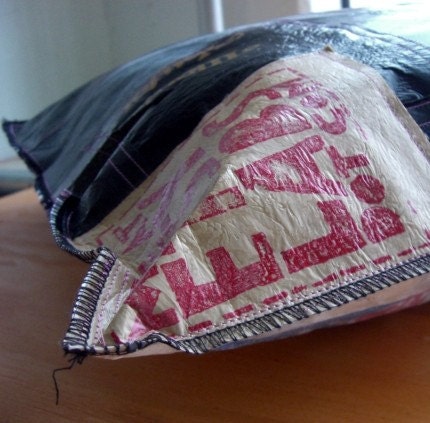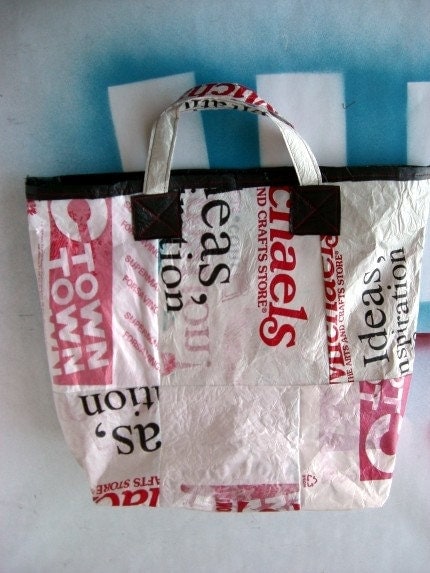THIS IS AN ETSY TUTORIAL THAT I HAVE COPIED AND PASTED HERE FOR YOU ALL TO READ. I THINK IT IS AN EXCELLENT WAY TO REUSE PLASTIC BAGS AND MAKE SOMETHING REALLY CLEVER. I TAKE NO RESPONSIBILITY AND THANK THE AUTHOR FOR HER CLEVERNESS. IT WAS ORIGINALLY POSTED BY SOMEONE NAMED AMANDA. THANK YOU AMANDA!
6 MAY 2007
Long Overdue Fusing Plastic Bag Tutorial

I realized this afternoon that I basically explain this technique to an Etsy Labs visitor at least once a day, but had never put the instructions online. So, here it is. Fusing! Plastic! Bags!
Do you have one zillion plastic drugstore and grocery bags under your sink, or perhaps smushed into a drawer? Ever wanted a cheap and easy use for them? One that leaves you with an intriguing and useful homemade craft supply? Do you have an iron? Why don't you fuse them together?
What you'll need
Plastic bags (thin, flimsy ones work best)
Parchment paper, freezer paper or plain old copier paper
Iron (and your favorite ironing surface)
Making it

Flatten out the bag and trim the bottom seam and handles off. This allows the bag to be opened up into a larger rectangle of plastic.

Turn the bag inside-out if it has printing on it. Once the ink heats up, it comes off the bag and makes a huge mess. If the bag has an interesting design that you'd like to preserve, try using a clear plastic bag layered on top of the printed one.
We find that between 6-8 layers of plastic gives the best results. So, you can either fold your bag twice until it is 8 ply thick, or use three or more bags layered on top of one another. Trying to fuse less than 6 layers often results in little holes forming in the finished piece and a generally weaker material.
Sandwich your plastic bags between the parchment paper

Next, run a hot iron (we set ours to "Rayon", but you will need to experiment a little to see what works for you) and keep the iron moving constantly. Make sure to get the edges, and after about 15 seconds, flip it over and iron the opposite side for a few seconds.

Peel a corner of the paper back to see if the plastic is fused together. It should be fairly smooth and "one sheet" to the touch (watch out, its a little hot). If the layers are not all melted together, iron it some more.


Peel the parchment paper away from the finished plastic sheet. Voila. Now, you can use this stuff to make a million things. We've made re-usable grocery totes, wallets, and floor cushions; I think its an inexpensive way to make waterproof linings for beach bags and makeup clutches.


Here are a few more rad examples of what you can do with this stuff, courtesy of Etsy seller Eclipse


Alright, y'all. Don't forget to open a window when you do this to avoid potentially brain-damaging fumes. Send us pictures of your creations, or add them to the Etsy Labs flickr pool

3 comments:
Wow! That is really cool!!
Brilliant!
I heard of something like this for the first time last weekend, so it's great to have a tutorial, too. I might have forgotten something important (like the parchment paper!!) otherwise.
Sue
Post a Comment